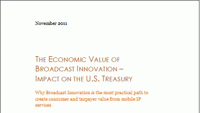Broadcast overlay network could generate $60 billion for Treasury, says report

The plan proposing a future Big Stick broadcast overlay of existing wireless operator networks will raise more than $60 billion for the U.S. Treasury — more than three times the amount projected from an auction of television broadcast spectrum, a new report says.
According to the report, “The Economic Value of Broadcast Innovation – Impact on the U.S. Treasury,” the broadcast overlay approach will allow thousands of TV stations to continue to exist and innovate. The work of Business Analytix, the report was released Nov. 15 by the Coalition for Free TV and Broadband and Sinclair Broadcast Group. The plan was previewed at a press conference held in Washington, D.C., at the national Press Club on Oct. 28.
The broadcast overlay envisioned by the plan uses high-power, high-tower television broadcast facilities to cover large areas for point-to-multipoint (broadcast) data/services capable of being converged with point-to-point (unicast) data/services provided by other wireless operators.
“A broadcast overlay service that is technically compatible with commercial wireless networks would allow users to consume more data at a lower cost with a higher quality of service and bring broadcasters new revenue opportunities through new ancillary services,” says Mark Aitken, VP of Advanced Technology for the Sinclair Broadcast Group. “Foregoing auctions of television broadcast spectrum would mean a win-win-win for the U.S. Treasury-consumers-broadcasters under this kind of a plan.”
The best way to meet the projected growth in mobile IP is to allow broadcasters to use point-to-multipoint broadcast overlay technology to provide the most efficient possible delivery of high-bandwidth data to mobile users, the report recommends. Commercial mobile networks based on cellular, one-to-one architectures are not designed to efficiently carry a portion of the mobile data traffic that is likely to grow the fastest.
“With spectrum remaining in the hands of broadcasters to address the growing demand for mobile data, they also create tremendous consumer and taxpayer value from mobile IP services,” says Rajiv Hazaray of Business Analytix. “The demands of a mobile data ecosystem are too diverse to be served only by cellular networks and commercial wireless operators. Different kinds of mobile data traffic require different networks and different service models.”
The professional video industry's #1 source for news, trends and product and tech information. Sign up below.
